Want To Avoid Crowds On Great Yosemite Moderates: Do These Five Routes
This article originally appeared on Climbing
This article appeared in Rock and Ice issue 183 (January 2010).
Yosemite National Park captured me at age 22. Within minutes of arriving at Camp 4, I was off jogging--literally running to the base of El Capitan. As I stood underneath the Zodiac, talking excitedly to two young men about to embark on a three-day journey, I knew the Captain was out of my reach since I maxed-out at 5.9 trad. But all around me were other walls, friendlier giants with lower angles and more consistent, well-protected cracks. With Higher Cathedral Spire right across the Merced River, the Brothers to the east, and the Manure Pile Buttress just around the corner, I didn't mind waiting for El Cap.
I compiled a list of all the perfect moderate classic routes I would do: The Regular Route (5.9) of Higher Cathedral, Snake Dike (5.7), the Central Pillar of Frenzy (5.9), and on and on. Unfortunately, crowds of climbers shared my dreams, and impeded my daily upward progress. The day I hiked up to Braille Book (5.8) with my 5.13-climbing German buddy, I practically wept as I watched two parties backlogged on pitch two and another party waiting below.
"Forget this shit!" I said, eyeing the guidebook impatiently. "Let's try The Sequel (5.8). It's just up the hill."
We waded through thick trees and vegetation to the other side of the Braille Book pillar. The gaping, dirty maw above elicited a grimace from my friend, but to me it was a glorious, totally people-free three-pitch adventure.
"Woo hoo!" I hollered repeatedly as I wedged myself into and up the sparsely protected chimney. I had found the answer to that age-old climbing question, "How the hell do you avoid the crowds on moderate classics?" Rather than depart at an obscenely early hour or climb quickly, which I couldn't do at the time, I delved into the world of less-traveled lines. Since then, I have checked out dozens of indistinct routes from California to Colorado. I've found stunning splitters and exciting faces, as well as some total choss piles. After doing the groundwork, I have come up with a list of excellent, mostly obscure moderates in Yosemite.
Don't expect 800 feet of splitter cracks. These lines include elements of the unknown, with wandering crack systems, daring runouts, and manky approach pitches. But they are moderate and they are fun, and while stacks of people wait in line below Serenity Crack (5.10d) and The Nutcracker (5.8), you will be cruising along at your chosen speed.
Super Slab/Slide (5.9)
Royal Arches Area
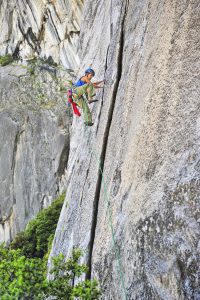
Little historical information about Super Slab/Slide exists, except for the fact that Gene Drake and Rex Spaith did the first free ascent sometime in 1971. The route lies just up and left of the Serenity Crack at the Royal Arches Area. Though oft-forgotten in conversation, Super Slab is likely well-traveled in reality, accepting the overflow from its famous neighbor. And, except for the first, chossy fifth-class pitch that leads to the base of the crack system (be sure to stay right on the pillar), it's a three-pitch splitter and well worth doing.
My partner on the route, the smiling Colorado strongwoman and Valley regular Heidi "Almighty" Wirtz, suggested Super Slab because daily thunderstorms required an easy approach and speedy climbing. A moderate route, Heidi claims, is "one on which you have to try a little bit and work a little bit, but you don't get pumped either mentally or physically." With just one section of straightforward 5.9 hand and finger crack, it fills the bill.
BETA
Four pitches. Park at the Ahwahnee parking lot and follow a worn trail to Serenity Crack at the Royal Arches Area. From there, head 100 feet up and left to the base of Super Slab. Climb the right side of Ahwahnee Buttress via fourth-class terrain and a short bit of 5.7 to a tree on a ledge. Belay at the tree. The excellent three pitches of Super Slab start out on the left side of the ledge. Pitch one follows a crack system up three short steep sections (5.7) to a two-bolt anchor. Pitch two continues up that crack system (5.8) to a three-bolt anchor. Pitch three continues up those cracks, ending with a perfect thin crack (5.9) before traversing left to a two-bolt belay just under a giant roof. Rap down the route, but rather than head back to the tree on the ledge, go straight down from the anchors at the first belay to a large tree directly below, from which you can reach the ground.
Commissioner Buttress (5.9)
Ranger Rock
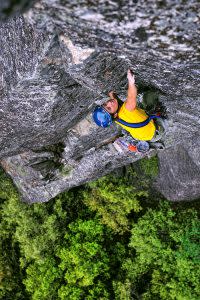
Put up by the prolific Valley climbers Galen Rowell and Joe Faint in March 1969, this route on Ranger Rock lies about 500 feet to the right of the well-traveled After Six (5.7) on Manure Pile Buttress. Rowell, who died in 2002 in a plane crash, described Commissioner Buttress in a 1970 American Alpine Journal report as "exhilarating" and "almost entirely in jam-cracks and chimneys."
The energetic and charming Valley lifer Ivo Ninov agrees. "It's a super cool, full-on adventure climb that doesn't see much traffic," he says.
Commissioner is also short and truly moderate, which is a good thing because the first time I tried to climb it with Ivo and four other people, we didn't reach the base until well after 5 p.m. and were rained off after pitch one. I finally finished the route days later after begging and bribing the thoughtful, rock star Madaleine Sorkin to hike up there with me late one evening.
After spending the day working on the free version of the West Face (V 5.13a A0) of the Leaning Tower (which she did a few days later), her only comment had been, "The hike better be short, and you're leading."
BETA
Two to four pitches. Park at El Cap Picnic Area, and hike five minutes to Manure Pile Buttress. Veer right before the base of Manure Pile up through a shallow gully. When you see a big spire jutting out of the trees as you head up the gully , ascend the hill another 10 minutes through the forest to its base. Start in an easy chimney that leads up and right to the bottom of a short, wide overhanging fist crack (5.9) that veers left. Then follow a long series of flakes and cracks. End at the top of a pillar, at a natural belay. The second pitch, which Rowell called "exhilarating," traverses left into a gully, and then up to gorgeous twin cracks, by a tree and through an intimidating but easy roof. Top out on the buttress and make a belay. Either climb two easier pitches to the top of the formation and descend off the west side, or descend after pitch two by climbing up and over some blocks and then down a short gully to two rappels on the east side of the buttress.
Regular Route (5.9)
Higher Cathedral Spire
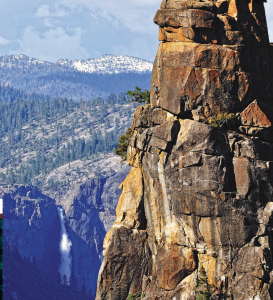
OK, admittedly there is nothing obscure about the Regular Route. Even the first ascentionists--Bestor Robinson, Jules Eichorn and Dick Leonard--fully scoped it before their ascent in April 1934, evaluating all existing photos of the wall with a microscope and protractor to determine that the average slope of the four faces was 81 degrees. An audience of five took photos and cheered from below as the Valley's first big-wall climbers traversed their way up the formation, utilizing two half-inch ropes, 13 carabiners and 55 pitons. Climbed without the use of aid 11 years later by Chuck Wilts and Spencer Austin, the route was also one of the earliest 5.9 free climbs in the Valley.
Still, it's a huge hike and a big adventure, and one of those nebulous 5.9s that, depending on which way you go, may seem more difficult. The first roof/bulge on pitch one, a variation done by Royal Robbins, borders on definitely harder than moderate. One of my partners, the cheerful sport-climbing diva Lauren Lee, upon reaching the top of that pitch, asked, "Do strong sport climbers ever end up just not leading cracks? That was so awkward!"
BETA
Four pitches. Approach via a climbers' trail at a road turnout 1.4 miles east of the junction of highways 41 and 140. Hike up between Higher Cathedral and Higher Cathedral Spire, and wind up and around the base to the left. Stop beneath the south face. This five-pitch route starts with a left-facing corner (5.5) that leads to the wide ledge "First Base." Build an anchor beneath Pitch 2, which starts at the far left end of the ledge. Follow a long crack through a bulge (5.9), or traverse left under a small roof for a more moderate 5.9 that leads to a steep bulge on good "bathtub" handholds. Climb past bolts, and belay at a tree above. Pitch three (5.9) goes up and left through a chimney to another tree anchor. As reported by Robinson in the Sierra Club Bulletin, this pitch is "excellent in its climbing possibilities, but dizzily overhanging hundreds of feet of empty space." Pitch four works up and left, following additional crack systems and ending up on a ledge, from which a superb flake leads to a juggy finish up the summit block. There are many variations to the top. Descend the route.
Absolutely Free Center (5.9)
Lower Brother
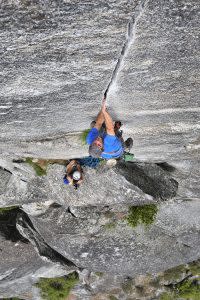
First put up by Mark Klemens, Sheldon Smith and Rick Sylvester, in August of 1970, Absolutely Free Center has "a little of everything, but mainly some very hard jam-cracks," as Sylvester wrote in a 1971 American Alpine Journal report.
According to my partner that day, the most judicious of Yosemite's dirtbags, Greg Loniewski, the route is "one of the most classic, infrequently done moderates in the Valley." With construction-scarred hands the size of most people's heads, Greg regularly free solos this stunning system of mostly wide cracks. His only warning: "The base of the route is difficult to find, requiring some serious munge-hummocking." In fact, the approach involves about 400 feet of fourth-class climbing over vegetated mounds of earth (hummocks) that adhere to rock like spit on glass.
In A Climber's Guide to Yosemite, Steve Roper described the Absolutely Free area in this way: "Seen from the West the Three Brothers are graceful and serene; seen from the east they present a chaotic mass of trees, ledges, and whitened and forbidding walls." It's this chaos that keeps the masses away, but nasty approach aside, this route is one of the finest, most well-protected lines in the Big Ditch.
BETA
Four pitches plus 400 feet of munge-hummocking. Park at a pullout just after the S-curve on the left side of the road .8 miles from Camp 4. Go around right from the toe of the Lower Brother to a right-facing dihedral, and scramble 400 feet of Class 4 and 5 terrain to a natural trough below a left-facing flake. From there, climb up to an alcove, through a cool chimney (5.7). Build an anchor. Pitch two, a 1.5-inch crack (5.9), and pitch three, a continuation of the same crack system, can easily be done together. Natural anchors are required. Pitch four follows a wide corner through an offwidth roof (that you can lieback) to the top of the Lower Brother, to another natural anchor. A bit tricky, the descent requires some potentially dangerous scrambling up various boulder problems to the base of the upper wall. Follow faint trails along the wall and down Michael's Ledge to the ground.
The Sequel (5.8)
Higher Cathedral
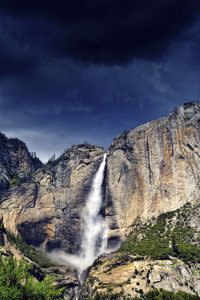
None of the Valley locals I spoke with had ever heard of or climbed The Sequel, and when I described it, I mostly got blank looks. "Why would you want to do something like that? No, thanks," Heidi said when I suggested it early in the trip. In order to get anyone to embark on the very long hike and to climb the route with me I had to lie.
"Let's do the ultra-classic Regular Route on Higher Cathedral," I suggested to my friend Lance Lemkau one morning. "We can finish before the storms hit if we move quickly enough."
Then I waffled and waited, and we didn't start hiking until late morning. Storms impending, I cheerily proposed another "really cool route just up the hill that we could do much faster." Tired and sweaty, Lance agreed, and before long I heard him cussing his way through the completely overgrown, steep, loose, dirt-covered, nearly non-existent trail. "People actually do this route?" he asked, staring up at it, eyebrows raised.
Established by Joe Faint and Chuck Pratt in October 1966, The Sequel follows one long, dark slash of a chimney up the far end of Higher Cathedral. There are a few loose blocks, including one fairly dangerous teetering chunk at the tail end of the third pitch, but 12 years after first doing it, more experienced and less intimidated by the other Valley giants, I returned for a follow-up ascent. I wanted a repeat of that exhilarating experience of wedging deep into Higher Cathedral, where I felt like I was uphill caving. After the sequel, so to speak, I still think it's one of the coolest routes I've ever done. And the same can be said for the rest of the moderates listed here.
BETA
Four pitches. Approach Higher Cathedral the same way you would approach Higher Cathedral Spire, but head right upon reaching the spire, up the talus for another 20 minutes. When you see the huge right-facing corner of The Braille Book, continue hiking uphill around the corner to the base of The Sequel. Pitches one and two follow a wide-open chimney that is full of handholds and stemming moves (5.7). Natural anchors are recommended, though some suspect webbing is tied around chockstones. Pitch three starts from a natural anchor at the bottom of a narrow squeeze chimney. The book rates this pitch 5.7, but it feels harder because gear and handholds are sparse. Build a natural anchor when you top out onto a big ledge. Pitch four (easy) traverses left up through a hold-covered face to the top of the formation. Descend by going up and left through manzanita and then down some slabs until you reach the gully. Drop onto a slope of giant boulders and talus until you eventually meet up with the approach trail.
Lizzy Scully lives, writes, and runs the nonprofit she co-founded, Girls Education International, from her small home in the foothills of Lyons, Colorado.
Also Read
Niels Tietze, YOSAR Member, Dies In Yosemite
Also Watch
For exclusive access to all of our fitness, gear, adventure, and travel stories, plus discounts on trips, events, and gear, sign up for Outside+ today.
